Wherever I travel, be it to my local antiques fair or a shop in foreign climes, I always make a bee-line for the tabletop cabinets. I know that no matter what their contents, I’m always sure to find a pair of handsome cufflinks hidden within. The pair that started my collection (pictured on previous page) was bought for a university ball. Looking like glittering buttons complete with gold thread, they seemed too good to be true, but turning them over, I found the all-important marks indicating that they were solid gold. A closer look revealed that the button panel was mother of pearl, highlighted with red enamel. I couldn’t get my £20 note out fast enough, even though I had so few of them then. I’ve never had such good fortune since, but that hasn’t stopped me trying!
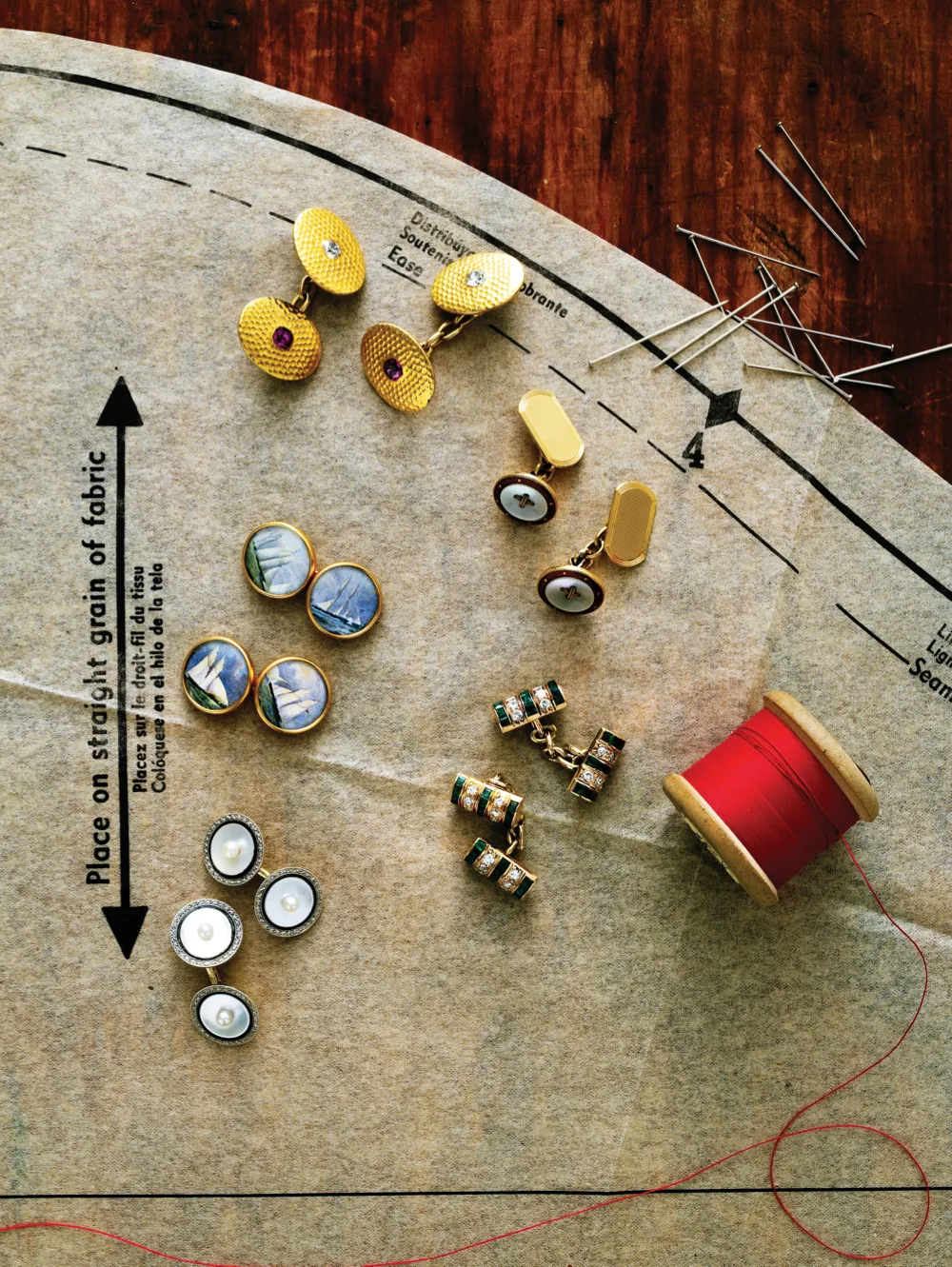
Historical links
Although it would be tempting to imagine the wrists of a Medieval courtier bedecked with sparkling jewels, cufflinks as we know them only became popular at the end of the 18th century, although earlier examples (usually converted ‘paste’ buttons) are known. It’s the development of the shirt from undergarment into something more that’s key here. Cuffs first crept out from sleeves as ruffs in the early 16th century, developing into less showy cuffs later, with both being fastened with strings or ribbon. By the turn of the 18th century, fashionable men realised that they could flaunt their status and wealth using the bejewelled buttons that adorned their shirts to replace these simple fastenings. By linking them together with a short chain, the cufflink was born.
By the mid 19th century, the cuff had evolved into the plain single-folded or double-folded ‘French’ versions that we know today. At the same time, link types diversified and grew to include push-button connections and swivelling bars, and machines were developed for die-stamping and electro-plating base metals such as alloys and brass. It was boom time for cufflinks.
Victorian values
19th-century cufflinks are often very simple, conforming to the values of the burgeoning middle classes. A pair of 1860s 18-carat gold cufflinks studded with turquoise may cost around £200-£400 today, but those in chased or embossed gold set with precious stones may be double that, if not more. As the century drew to a close, designs became more decorative and complex, with cufflinks once again used to indicate wealth and status. Materials and inspirations often came from far-flung lands: sapphires and diamonds from the Empire, or archaeological discoveries in Egypt. Notable makers include Child & Child, E. W. Streeter, Tiffany & Co. and Fabergé.
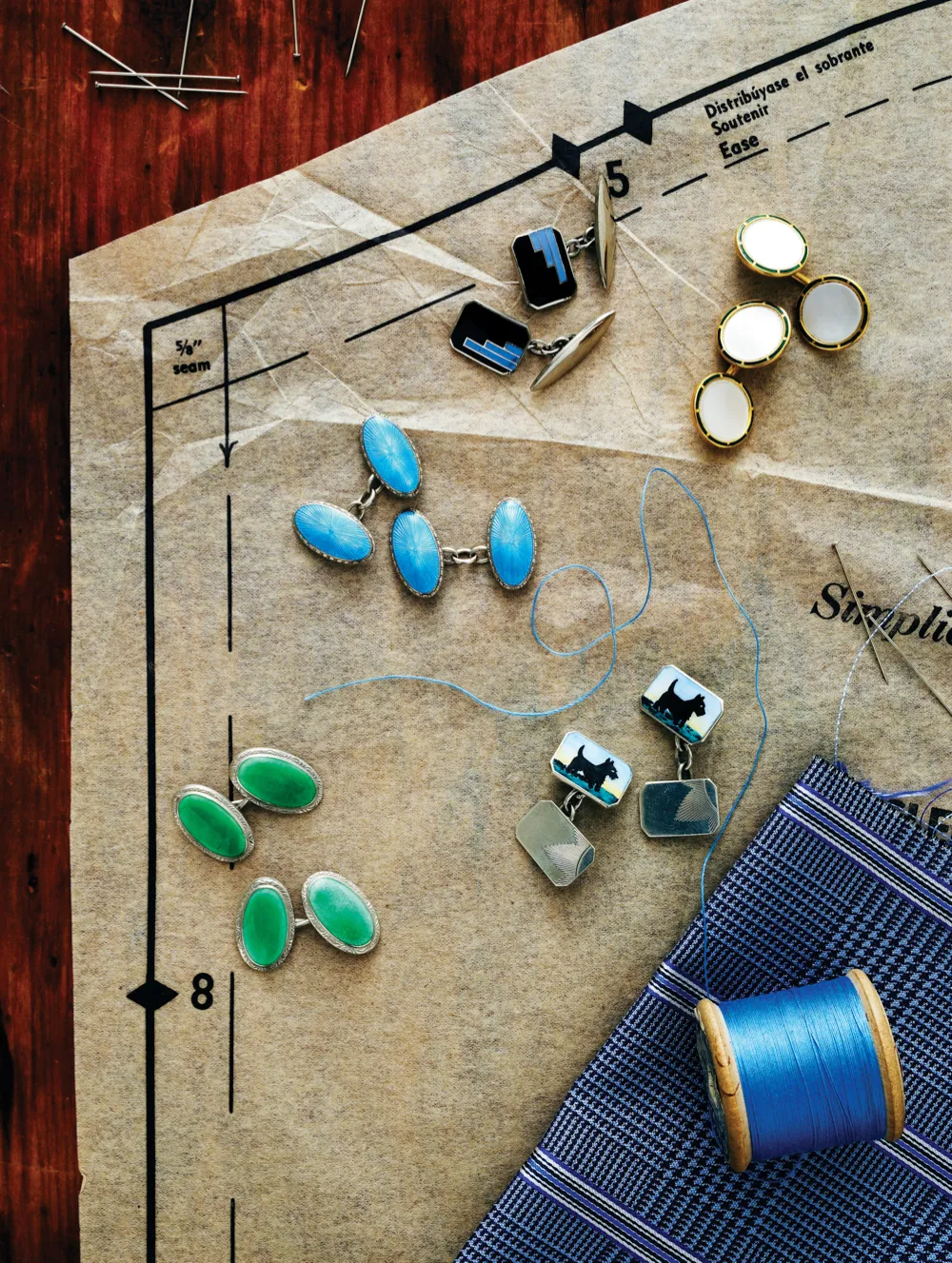
Led by a Queen in mourning, Victorian sentimentality was also reflected in the use of more sombre pearls, onyx and black jet. This style became the height of fashion in the 1920s; examples can be found for anything from £50-£150, depending on the quality and materials used.
The prevalent decorative style of the day, be it Arts and Crafts or Art Nouveau, also manifested in these tiny items. Enamelling, embossed metals and semi-precious stones were frequently combined to create sinuously curving vines, butterflies and elegant ladies, often with an obvious ‘handmade’ feel. Art Nouveau examples in base metals can be found for around £30-£80, although precious materials or an attribution to a leading designer or company, such as Georg Jensen or Liberty & Co., would triple that at least. John Szwarc of The Cufflink Shop tips the French maker Fix, whose good quality Art Nouveau links can usually be found for upwards of £20-£30.
Edwardian elegance
Flamboyant fashions continued into the early 20th century, with bright enamels or semi-precious stones providing a touch of the dandy to sober suits. Edward VII and his son Prince George led the pack (George’s son Edward had a penchant for them too – the diamond and platinum pair given to him by Wallis Simpson later sold at auction for $440,000) buying from the renowned jewellery houses of Fabergé, Tiffany and Cartier, while regional jewellers fashioned their own versions.
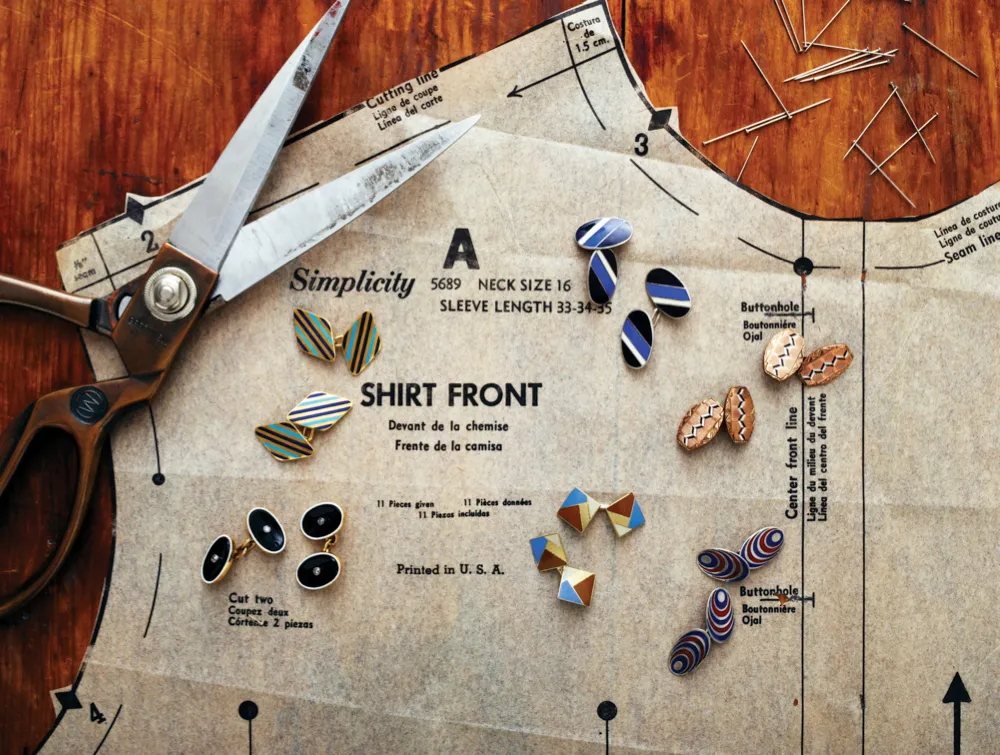
Engraved and enamelled guilloché designs became popular, with fine-lined waves and sunrays adding a shimmering effect to a rainbow of vibrant colours. Many were studded with pearls or coloured stones. Variety abounds, and prices for undamaged examples range from £50-£300.
Heraldic designs of this period are also abundant and sometimes come with a fascinating history. Not so long ago, I picked up a brass pair for £2. On researching their motto – Virum extuli mari (‘I saved a man from the sea’) – I discovered that they most likely date from shortly after 1906, when a Newfoundland dog saved two children from drowning in New Orleans. A word of warning, though: if you’re buying as an investment, unless there’s a nice story, a good connection or a famous owner attached, avoid monogrammed initials (unless they’re yours!) and simple, repetitive designs typically found on gold or gold-plated, oval shapes, as these are unlikely to rise much in value.
The roaring Twenties
Enamelled designs continued to be popular into the 1920s and 30s, but they danced to a new tune – that of the Jazz Age and the Art Deco movement. Bold, bright colours were contrasted in angular, geometric designs. For me, this period provides the greate
st scope for building an eye-catching collection, as you can buy a pair of silver or gold plated examples from as little as £30-£50. Interestingly, silver or silver-plated designs are often more avant garde than gold designs.
If you want something really special, look for links in the then newly fashionable platinum and white gold, which would have been worn with evening dress. Set with sparkling diamonds, calibre-cut emeralds, sapphires or rubies, the results are breathtaking – particularly if the design is three-dimensional. So are the prices, however, with a good pair costing £1,000-£1,500 or more.
Plastic fantastic
With the Great Depression biting, manufacturers turned to cheaper materials, making novelty designs, such as dice, in vibrant Catalin and Bakelite, or plastic domed, gold-plated examples featuring sporting scenes. Mass-produced from the 1930s-50s, typical motifs include hunting dogs, game birds, race horses or golfers. Values depend on the detail and quality of the printed scene, but range from £20-£30 upwards.
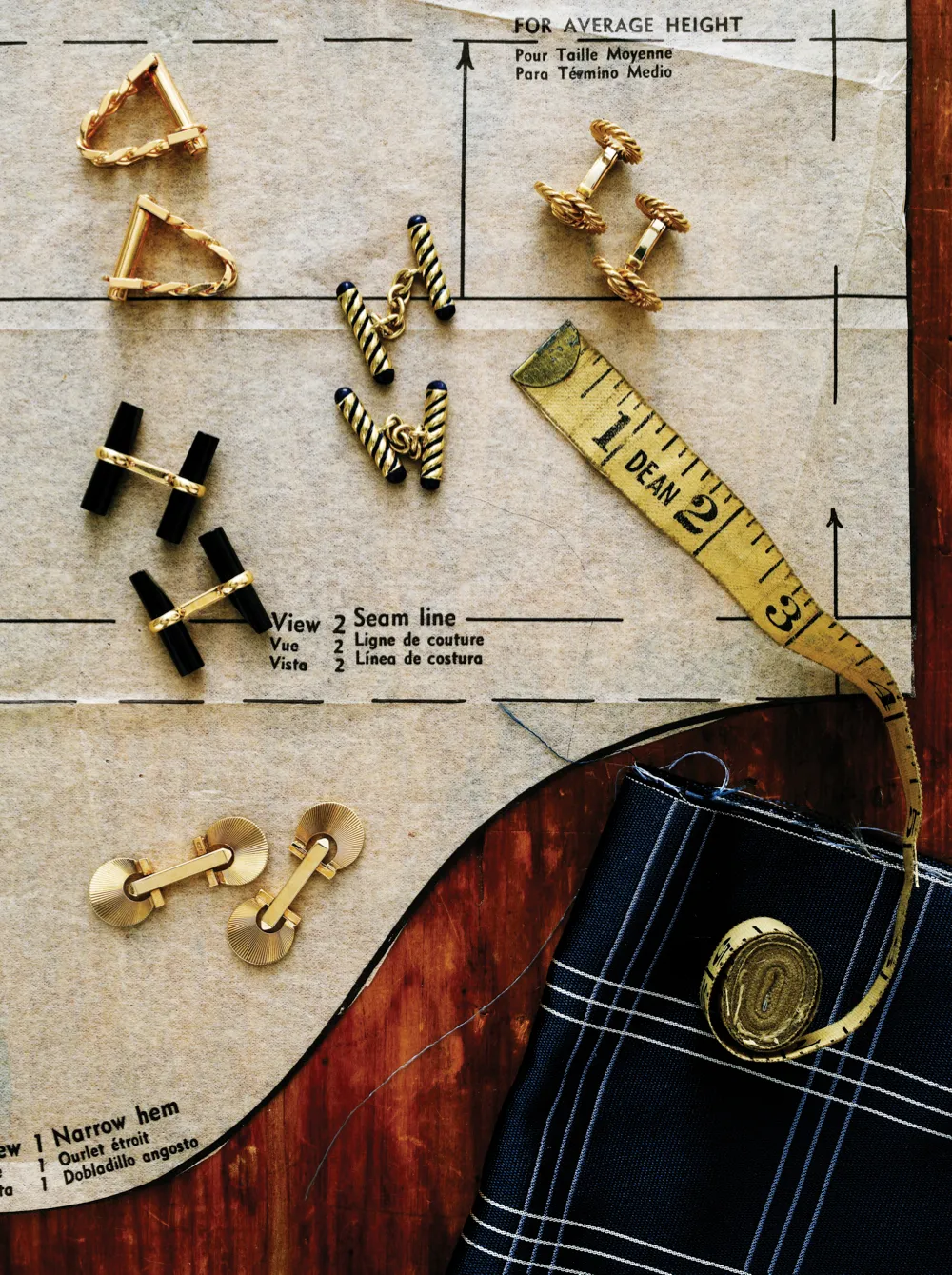
Often inexpensively manufactured, companies such as Swank and Destino churned out millions of silver and gold-effect links after the war, in a variety of whimsical forms, from pistols and cars to playing cards. Selling for under $10 at the time, they are still very affordable – most can be found for around £30-£50 or less.
In the 1950s and 60s, leisurewear and the ready-sewn plastic buttons on shirt cuffs sounded a death knell for the cufflink. Those firms that did still make them produced chunky, space-age designs, textured, or inset with large cabochons in coloured glass or stones such as tiger’s eye. At the upper end of the market, French makers such as Cartier, Van Cleef & Arpels, Hermès and Boucheron became known for stirrup shapes, among others, that appear to ‘grip’ the sleeve.
Happily, snappy dressing is once again in vogue and today’s market for cufflinks is lively and varied with men having an almost unlimited choice of materials, designs, period, style and value. A sense of fun and simple ‘eye appeal’ should not be disregarded however. Wearability is key to desirability - cufflinks are still almost the only socially acceptable items of jewellery a man can wear to express his true character – albeit tastefully and discreetly.
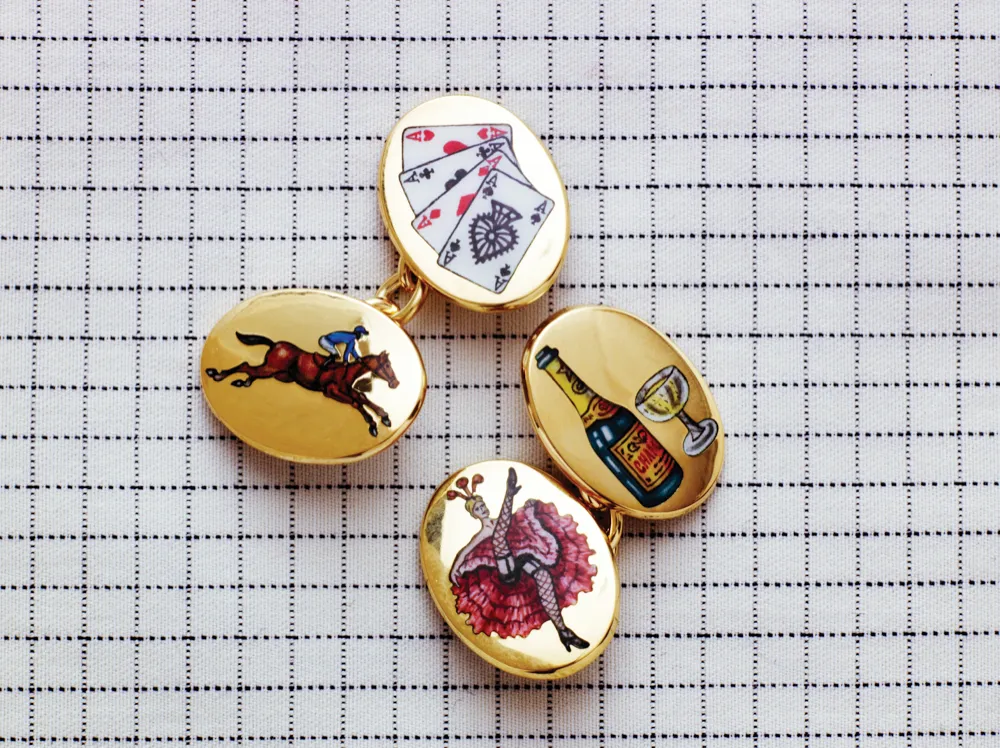
THE FOUR VICES
For many people, the ‘Holy Grail’ of cufflink collecting is a pair of original Edwardian ‘Four Vices’ links. Also known as ‘the Road to Ruin’, these were made in solid gold, and enamelled with images of either a cocktail glass or champagne bottle; a race horse; a cancan dancer and a playing card or two. Originals are incredibly rare – the best can easily fetch well over £1,000 – and they are often reproduced by applying new enamel to old gold. Birmingham-based cufflink makers Deakin & Francis (est. 1786) has been one of the leading makers of this style since c1910. Contemporary examples (pictured right) are produced using old tools and techniques. In solid gold, with hand-painted enamel, they will set you back £1,800 a pair. If you have a smaller budget, printed or less well-enamelled examples can be found from around £100-£200.
FIND OUT MORE
BUY
BENTLEY & SKINNER 8 New Bond Street, London. 020 7629 0651.
CAD VAN SWANKSTER at The Girl Can’t Help It!, Alfies Antiques Market, 13-25 Church Street, London. 020 7723 6066.
THE CUFFLINK SHOP The Antique Centre 58-60 Kensington Church Street, Kensington, London,W8 4DB. 02073763149
DEAKIN & FRANCIS Regent Place, Birmingham. 0121 236 7751.
FELLOWS & SONS AUCTIONEERS 19 Augusta Street, Birmingham. 0121 212 2131.
GRAY’S ANTIQUE MARKET 58 Davies Street, London, is home to Wimpole Antiques (020 7499 2889); Anthea Antiques (020 7493 7564) and Linda Bee (020 7629 0651)
SANDRA CRONAN 38 Old Bond Street London. 020 7491 4851.
WARTSKI 14 Grafton Street, London. 020 7493 1141.
READ
CUFFLINKS, by Susan Jones & Marilyn Nissenson, published by Abrams, 1999
VIEW THE COURTAULD COLLECTION in Somerset House, Strand, London, and the jewellery gallery at the Victoria & Albert Museum, South Kensington, often include fine cufflinks in their displays
PHOTOGRAPHS: NATO WELTON
STYLING: JO BARNES